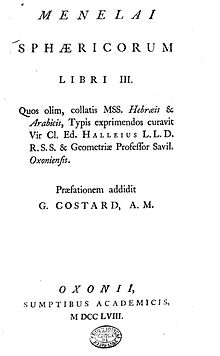Menelaus of Alexandria
Menelaus of
Life and works

Although very little is known about Menelaus's life, it is supposed that he lived in Rome, where he probably moved after having spent his youth in Alexandria. He was called Menelaus of Alexandria by both Pappus of Alexandria and Proclus, and a conversation of his with Lucius, held in Rome, is recorded by Plutarch.
In the 10th-century
The lunar crater Menelaus is named after him.
Bibliography
The titles of a few books by Menelaus have been preserved:
- On the calculation of the chords in a circle, composed of six books
- Elements of geometry, composed of three books, later edited by Thabit ibn Qurra
- On the knowledge of the weights and distributions of different bodies
- He may also have written a star catalogue.
Notes
- ^ Encyclopædia Britannica "Greek mathematician and astronomer who first conceived and defined a spherical triangle (a triangle formed by three arcs of great circles on the surface of a sphere)."
- ISBN 978-1-4419-9916-0.
References
- Ivor Bulmer-Thomas. "Menelaus of Alexandria." Dictionary of Scientific Biography 9:296-302.
- Pedro Pablo Fuentes González, “Ménélaos d’Alexandrie”, in R. Goulet (ed.), Dictionnaire des Philosophes Antiques, vol. IV, Paris, CNRS, 2005, p. 456-464.
- Roshdi Rashed and Athanase Papadopoulos, Menelaus' Spherics. Early Translation and al-Māhānī / al-Harawī's Version. De Gruyter, Scientia Graeco-Arabica 21. xiv, 874 pages. ISBN 978-3-11-056987-2
